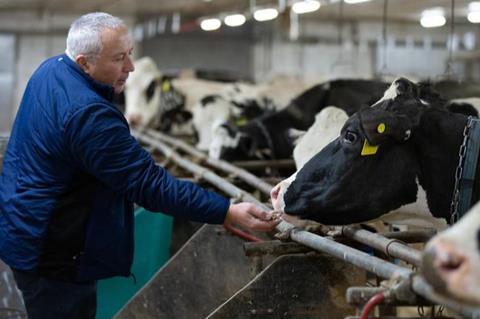This week, representatives from nearly 200 countries reached an agreement at the COP28 climate summit in Dubai to begin reducing global consumption of fossil fuels in efforts to reduce carbon emissions and stave off the worst-case scenarios of climate change.

Mary Ann Bruns, Penn State professor of soil microbiology and biogeochemistry, served on the steering committee for a colloquium held in June by the American Academy of Microbiology, the scientific think tank for the American Society for Micobiology. The group just released its colloquium report, The Role of Microbes in Mediating Methane Emissions.
The report advocates for greater recognition of the microbial processes involved in methane production and consumption as society seeks solutions to reduce greenhouse gas emissions and address climate change.
In an interview with Penn State News, Bruns said:
Q: This past year was the hottest on record, with parts of the world experiencing deadly heat waves, and there were other extreme weather events like droughts and wildfires. These are big problems and what your report is saying is that the solution may be very small, microscopically small in fact. Can you explain that?
Bruns: Yes. We’re making the point that there is an urgent need to include microbiologists in climate discussions, because microbes drive carbon cycling processes in nature as they decompose and transform wastes. So, even though they’re tiny, the accumulated activities of these microorganisms are responsible for big changes to our planet.
Q: This report points to microbes as the solution as well as the problem. How can they be both the problem and the solution at the same time?
Bruns: Microbes have a great potential to mitigate the harm that anthropogenic emissions are having on the climate. Although microbes emit carbon dioxide during waste decomposition, they also transform carbon into stable forms that remain in soil. Although microbes generate methane in anoxic environments, or water systems that have been depleted of dissolved oxygen, there are other microbes in healthier, oxic environments that consume it. Microbes have the capacity to reduce flows of greenhouse gases into the atmosphere or prevent the gases from accumulating the first place.
Q: In this report, you focus specifically on methane, which is a greenhouse gas that is discussed far less frequently than carbon dioxide. Why did you and your colleagues decide to focus on methane?
Bruns: There are three main global warming gases: carbon dioxide, nitrous oxide and methane. Methane is a very potent greenhouse gas — it’s actually 80 times more potent than carbon dioxide, so that means methane’s warming power is about 80 times greater than carbon dioxide over a 20-year period. While efforts must still be made to reduce carbon dioxide emissions, methane’s potency means that reducing its emissions is an effective way to slow the rise of global temperatures in the near term.
In short, the reason we’re focusing on methane is because microbiological knowledge can be applied to cut methane right now while we decrease dependency on fossil fuels. Lower methane emissions today will slow temperature increase and reduce the short-term feedbacks that accelerate warming.
Q: Where can real change be made right now?
Bruns: The four areas highlighted in the report for using microbial approaches to reduce methane emissions are ruminant animals, animal wastes, rice paddies and landfills.
Agriculture represents the greatest source of methane production, particularly from ruminants — livestock like cows and sheep — because they belch out methane. We’re realizing how important it is to understand the microbial communities in these animals’ rumens, the largest part of their digestive systems. Researchers at Penn State’s College of Agricultural Sciences have made great progress on that front, but even more progress can be made.
Another area is animal wastes, essentially mitigating or minimizing methane emissions from waste storage. Animal waste lagoons are a major source of methane emissions, so we need to start implementing waste treatment methods to mitigate those emissions.
The third area is rice production, because rice paddies are sources of methane production as well, so adopting practices like periodically drying out fields could dramatically decrease the level of methane emissions from rice cultivation.
And the final focus area is landfill methane emissions. That all comes down to landfill design and engineering, which is important in controlling and constraining the levels of methane that are emitted from landfills. Much of the methane coming from landfills could be prevented simply by designing landfills so there’s less methane produced and more captured within covers.
Q: Are lower emissions actually within reach?
Bruns: It’s absolutely within reach if we work on multiple fronts. We can reduce methane emissions by promoting methane-oxidizing landfill covers. We can develop cattle diets that establish rumen microbiomes to produce less methane. We can foster carbon-sequestering soil microbiomes through climate-smart agricultural practices. When we talk about slowing climate warming, there is no “silver bullet.” Instead, we can take a “silver buckshot” approach to achieve reduced emission from a whole host of sources at once.
Microbes — which are major consumers and producers of methane — are vital to addressing the issue of greenhouse gas emissions.
Q: What is something that gives you hope when you think about how your field can contribute to combatting the climate crisis?
Bruns: Right now, the study of microorganisms is undergoing a vast “microbiome revolution.” We have powerful DNA sequencing and metabolomic tools to study and characterize microbial communities, capabilities that we’ve never had before. We’re starting to see a concerted effort to better understand how microbes impact our environment, which I’m hopeful will provide a path forward to protecting our planet.







No comments yet